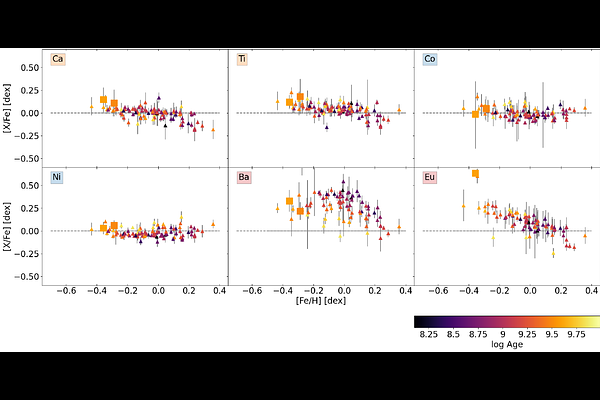Open clusters in the outer disc studied with MEGARA@GTC Auner 1 and Berkeley 102

Open clusters in the outer disc studied with MEGARA@GTC Auner 1 and Berkeley 102
J. Carbajo-Hijarrubia, R. Carrera, F. Anders, C. Jordi, L. Casamiquela, L. Balaguer-Núñez, A. Gil de Paz
AbstractOpen clusters offer crucial insights into stellar nucleosynthesis and the chemical evolution of the Galactic disc, as their ages and distances can be determined with higher accuracy compared to field stars. In this study, we investigate the outermost regions of the Milky Way disc using two previously unstudied open clusters -Auner 1 and Berkeley 102- located at Galactocentric distances of approximately 14 kpc in largely uncharted areas of the Galaxy. We obtained medium-resolution spectra (R > 18,700) using the MEGARA integral-field unit (IFU) spectrograph on the 10.4 m Gran Telescopio Canarias (GTC), targeting red giant member stars in both clusters. From these spectra, we derived radial velocities, stellar atmospheric parameters, and chemical abundances for six elements: Fe, Ca, Co, Ni, Ba, and Eu. Additionally, we provide updated estimates of the clusters' ages and distances. Both clusters are old (3.2 +- 0.7 Ga), distant (d ~ 8 kpc), and lie below the Galactic plane (Z Gal ~ -0.7 kpc), with moderate extinction (AV ~ 1.3 mag). We find that Auner 1 has a metallicity of [Fe/H] = -0.30 +- 0.09 and Berkeley 102 of [Fe/H] = -0.35 +- 0.06, consistent with other clusters at similar Galactocentric radii and indicating minimal azimuthal variation in metallicity. The [X/Fe] abundance ratios align with expected trends, although [Ca/Fe] is slightly higher in both clusters, and [Eu/Fe] is notably enhanced in Berkeley 102 ([Eu/Fe] = 0.64 +- 0.05). Our findings highlight the effectiveness of GTC/MEGARA in IFU mode for Galactic archaeology and emphasize the need for further medium-to-high resolution spectroscopic studies of remote open clusters to refine models of the outer Galactic disc's chemical evolution.